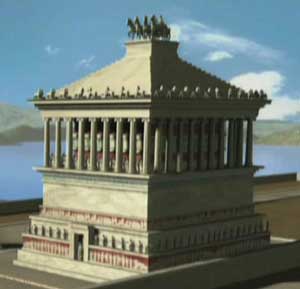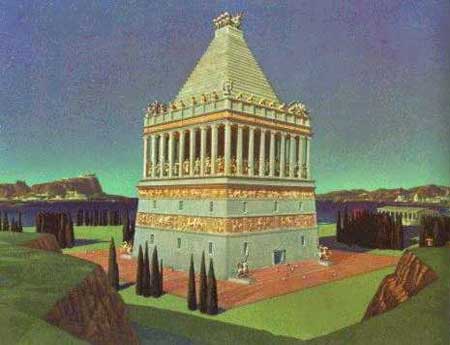Tomb at Halicarnasse
 After the construction period Parthénon, Greece moved from the classical period to the post-classical period. At that time, the city was somewhat depressed, the community sentiment weakened, people returned to their personal feelings. Therefore, the architecture of the King is of a large size in order to "scare" people, while the sculptures are small in size, becoming a place to enjoy in the living rooms.
After the construction period Parthénon, Greece moved from the classical period to the post-classical period. At that time, the city was somewhat depressed, the community sentiment weakened, people returned to their personal feelings. Therefore, the architecture of the King is of a large size in order to "scare" people, while the sculptures are small in size, becoming a place to enjoy in the living rooms.
The most famous architectural work of this period was the King Mausole tomb at Halicarnasse. The city of Halicarnasse is the capital of the Carie Kingdom located on the West Asian land right next to Egée sea. The tomb at Halicarnasse dating from around 350 BC, is the largest and most elaborate tomb of the time, built by Queen Artémise for her husband, King Mausole.
The tomb of Halicarnasse is one of the seven wonders of the Ancient world, but it is also the last mark to mark the disintegration of slavery in Ancient Greece. It was also the last attempt of a King, because the ancient Greek world did not like the big tomb. The structure of the tomb works at Halicarnasse has a large shape and serious composition, which can explain its massiveness by the Greek post-art era strongly influenced by Eastern art.
The work is divided into three parts:

The largest base below is the floor for the body to be built of stone with the ground being extended in a three-level style.
On the second floor inside there is a sacrificial room, the outside is surrounded by a row of columns, so the architectural form of this floor is somewhat gentle, in contrast to the solid block below due to the open spaces formed. to the final column, along with placing statues between columns; and these ingredients fall to the back wall. So here the forms of architecture and sculpture are very flexible, with flexible nuances.
The third top part is a shape of a similarly shaped pyramid, like a pyramid, leveling up and up to the top, ending with a cluster of Mausole statues.
In architecture, the tomb at Halicarnasse belongs to the grave tomb (Herong). The author of this architecture is architect Pitheos - a famous ancient architect, while sculpting the tomb by the four most talented sculptors of the time, led by Scopas and Leochares.
 Through many ups and downs of history, time and war, because of earthquakes, looting, because of hatred among the clans, religion Halicarnasse's tomb was gradually eroded. By the sixteenth century the Turks had made the tomb in Halicarnasse become a landmark. Later, after nearly a century and a half of excavation and collection, based on the collected details, people tried to reconstruct the image of the tomb at first. Kiecon's restoration scheme was made from 1923 to 1928, it can be said to be the most honest restoration project.
Through many ups and downs of history, time and war, because of earthquakes, looting, because of hatred among the clans, religion Halicarnasse's tomb was gradually eroded. By the sixteenth century the Turks had made the tomb in Halicarnasse become a landmark. Later, after nearly a century and a half of excavation and collection, based on the collected details, people tried to reconstruct the image of the tomb at first. Kiecon's restoration scheme was made from 1923 to 1928, it can be said to be the most honest restoration project.
Mausole's tomb was originally a private name, then gradually came out of that narrow case to become a common name, used to call large-scale graves built for celebrities. The word "mausoleum" in many languages Mosole, Mausolée, Mauzoleum, Mavzalei has its original origin from the tomb of King Mausole in the Carie region located on the Mediterranean coast.
- Scary discovery about 1,400-year-old 'tomb of ghosts'
- The tombs are the most mysterious in the world
- The secret of an ancient tomb is 800 years old in China
- Discovered a 4,400-year-old tomb in Egypt
- Found the tomb of Jesus?
- Discover the oldest tomb of the Maya period
- The secret still covers the tomb of Qin Shihuang
- China excavated the tomb of Qin Shihuang's grandmother
- Excavating the tomb of Qin Shui Huang, discovering the animal world inside
- The mystery of the tomb Qin Shihuang
- Close to the ancient tomb discovered in Saigon
- 2,000-year-old tomb in Mexico
 Norway built the world's tallest wooden tower
Norway built the world's tallest wooden tower Kremlin
Kremlin Ashurbanipal: The oldest royal library in the world
Ashurbanipal: The oldest royal library in the world Decoding the thousand-year construction of Qin Shihuang shocked the world
Decoding the thousand-year construction of Qin Shihuang shocked the world Archaeologist unearths strange 'dragon' in field, expert: 'Report to police as soon as possible'
Archaeologist unearths strange 'dragon' in field, expert: 'Report to police as soon as possible'  'Never Known' Species Found in Qin Shi Huang's Grandmother's Tomb
'Never Known' Species Found in Qin Shi Huang's Grandmother's Tomb  The ancient tombs were all sealed from the inside, how did the last worker escape?
The ancient tombs were all sealed from the inside, how did the last worker escape?  Egyptologist suffers mysterious illness while opening ancient tomb
Egyptologist suffers mysterious illness while opening ancient tomb  Digging a 3,500m high 'water tomb', China found a huge treasure mine, the secret of the Silk Road is revealed!
Digging a 3,500m high 'water tomb', China found a huge treasure mine, the secret of the Silk Road is revealed!  The world's oldest earthquake-proof tomb
The world's oldest earthquake-proof tomb 